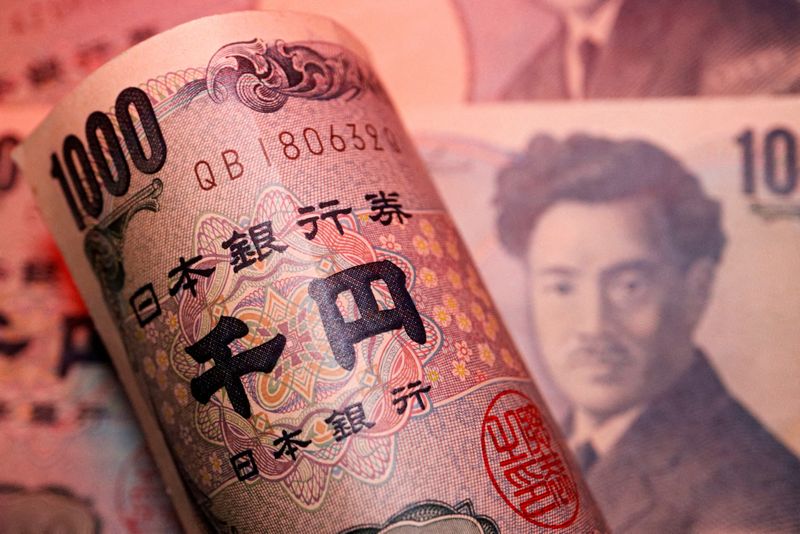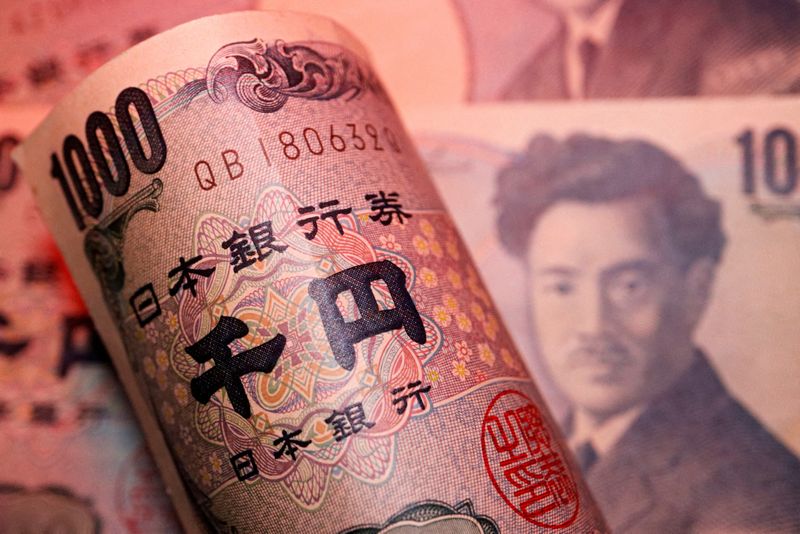Forex
Yen drifts lower from 2-1/2-month peak vs dollar as markets stabilize

By Gertrude Chavez-Dreyfuss
NEW YORK (Reuters) -The yen edged lower from a 2-1/2-month high against the U.S. dollar on Thursday, as financial markets stabilized, with investors looking ahead to next week’s Bank of Japan meeting which could see a potential rate hike.
The Japanese unit this week rallied sharply as market participants unwound their long-held bets against the currency. At the same time, a plunge in global stocks in recent sessions had driven investors toward traditionally safe assets such as the Swiss franc and yen.
U.S. equities, however, recovered on Thursday after a steep sell-off in the previous session.
For the week, the yen has risen 2.4%, on track for its best weekly gain since late April. The greenback was last slightly down at 153.84 yen.
The dollar, however, trimmed losses against the yen and euro after data showed the world’s largest economy expanded faster than expected and inflation slowed in the second quarter. That reduced brewing expectations of a larger-than-expected rate cut in September, or a sudden Federal Reserve easing at next week’s meeting.
“The Japanese yen is flatlining on diminished safe-haven demand, and the speculative fervor behind its recent bull run seems to be running out of steam,” said Karl Schamotta, chief market strategist at Corpay in Toronto.
“We think markets have gotten a little too far over their skis given that underlying economic fundamentals don’t yet support a rapid tightening cycle from the Bank of Japan, and that rate differentials will remain wide even if the Fed begins cutting in coming months.”
The rate futures market has priced in a 67.2% chance that the BOJ will raise rates next week by 10 basis points (bps), up from about 40% earlier in the week, according to LSEG estimates.
The euro was slightly up against the dollar at $1.0846 , with the flat at 104.36. The index was at 104.21 just before the release of economic growth data.
Advance estimates showed that U.S. gross domestic product (GDP) grew at a 2.8% annualized rate in the last quarter. Economists polled by Reuters had forecast GDP rising at a 2.0% rate.
The personal consumption expenditures (PCE) price index, excluding the volatile food and energy components, increased at a 2.9% rate after surging at a 3.7% pace in the first quarter.
Against the Swiss franc, the dollar dropped 0.5% to 0.8806 francs.
AHEAD OF ITSELF
“The market got ahead of itself on Fed cuts. Before the GDP number, the market is pricing as if the Fed is going to cut 50 basis points in September,” said Marc Chandler, chief market strategist at Bannockburn Forex in New York.
He also cited comments from former New York Fed President Bill Dudley in a Bloomberg column on Wednesday, who said the Fed should cut rates next week, citing recent employment data.
“The GDP number shows that the Fed is not under that kind of urgency,” Chandler said.
The Fed remains firmly on track to cut interest rates in September, according to fed funds futures data. The futures market has also priced in about 68 basis points (bps) of cuts this year, based on LSEG calculations.
U.S. jobless claims data were also consistent with an economy still holding up well.
Initial claims for state unemployment benefits dropped 10,000 to a seasonally adjusted 235,000 for the week ended July 20, the data showed. Economists polled by Reuters had forecast 238,000 claims for the latest week.
The only blemish, however, was the U.S. durables report, which showed durable goods orders fell 6.6% in June on slumping transportation orders, compared with expectations for a 0.3% rise.
In other currencies, the Australian dollar fell to US$0.6519, its lowest since early May. It was last down 0.6% against the greenback at US$0.6541.
rallied against the dollar, which fell to its lowest since early May at 7.205, as the yen’s rally spilled over to the Chinese unit. The dollar was last down 0.2% at 7.245
Currency
bid
prices at
25 July
07:28
p.m. GMT
Descripti RIC Last U.S. Pct YTD Pct High Low
on Close Change Bid Bid
Previous
Session
Dollar 104.31 104.38 -0.05% 2.90% 104.45 104.
index 07
Euro/Doll 1.0852 1.084 0.12% -1.68% $1.087 $1.0
ar 829
Dollar/Ye 153.9 153.86 0.01% 9.09% 154.3 151.
n 96
Euro/Yen 1.0852 166.79 0.13% 7.31% 167.59 164.
83
Dollar/Sw 0.8806 0.8852 -0.53% 4.62% 0.8854 0.87
iss 78
Sterling/ 1.2861 1.2906 -0.33% 1.08% $1.2913 $1.0
Dollar 829
Dollar/Ca 1.3808 1.3808 0% 4.16% 1.385 1.37
nadian 97
Aussie/Do 0.6549 0.6582 -0.46% -3.92% $0.6582 $0.6
llar 511
Euro/Swis 0.9554 0.9594 -0.42% 2.89% 0.9598 0.95
s 22
Euro/Ster 0.8435 0.8397 0.44% -2.69% 0.8439 0.83
ling 95
NZ 0.5893 0.593 -0.68% -6.8% $0.593 0.58
Dollar/Do 73
llar
Dollar/No 11.0151 11.0265 -0.1% 8.68% 11.1381 10.9
rway 83
Euro/Norw 11.9548 11.953 0.02% 6.49% 12.0856 11.9
ay 317
Dollar/Sw 10.8111 10.7772 0.31% 7.39% 10.8685 10.7
eden 65

Euro/Swed 11.7314 11.6822 0.42% 5.45% 11.7786 11.6
en 784

 Forex3 years ago
Forex3 years agoForex Today: the dollar is gaining strength amid gloomy sentiment at the start of the Fed’s week

 Forex3 years ago
Forex3 years agoUnbiased review of Pocket Option broker

 Forex3 years ago
Forex3 years agoDollar to pound sterling exchange rate today: Pound plummeted to its lowest since 1985

 Forex3 years ago
Forex3 years agoHow is the Australian dollar doing today?

 Cryptocurrency3 years ago
Cryptocurrency3 years agoWhat happened in the crypto market – current events today

 World3 years ago
World3 years agoWhy are modern video games an art form?

 Commodities3 years ago
Commodities3 years agoCopper continues to fall in price on expectations of lower demand in China

 Economy3 years ago
Economy3 years agoCrude oil tankers double in price due to EU anti-Russian sanctions



























